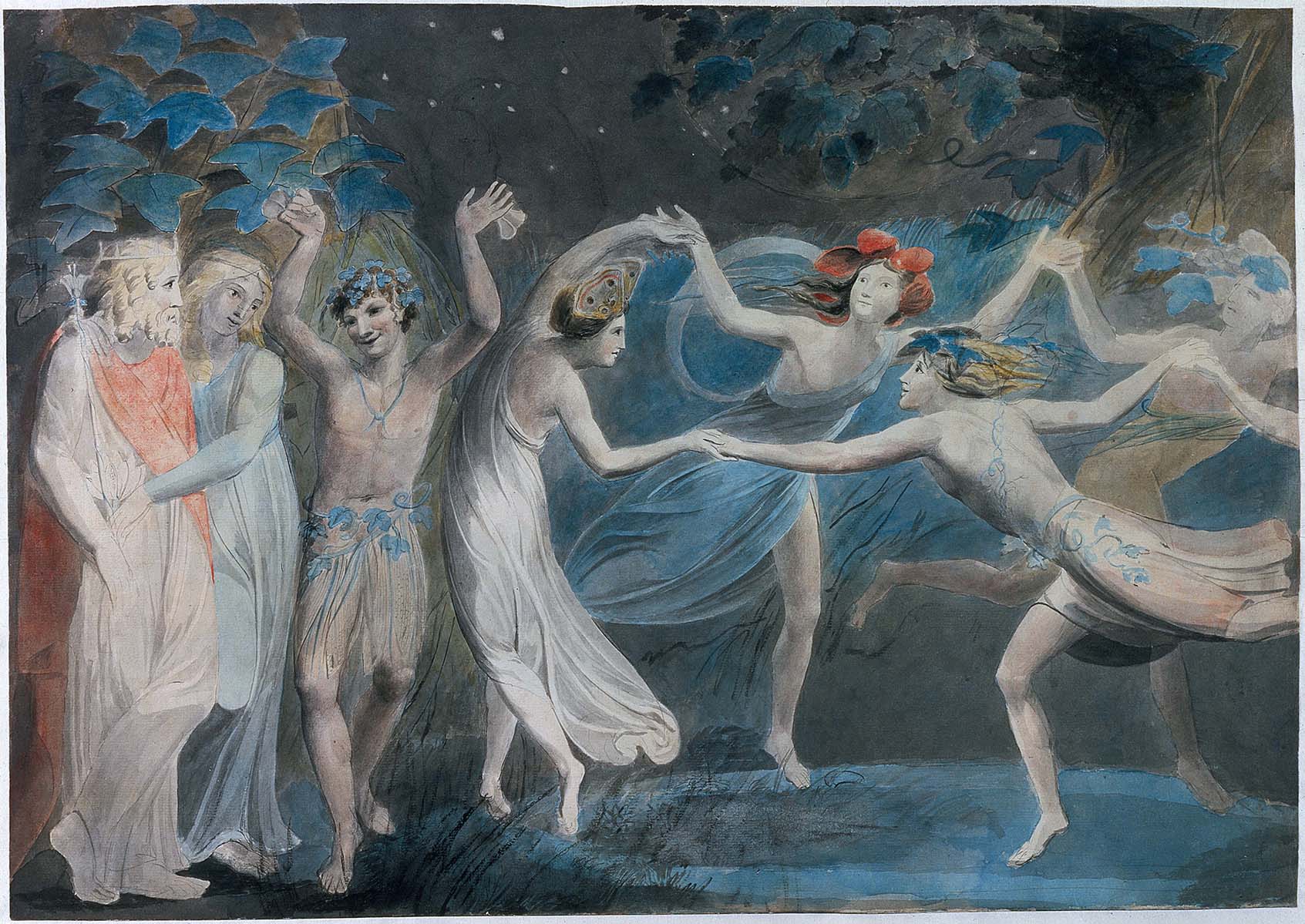The William Blake Archive is pleased to announce the publication of a digital edition of Blake’s water color illustrations to the plays of William Shakespeare.
Although less extensive and well known than his illustrations of John Milton’s poems, Blake’s water colors based on Shakespeare’s plays constitute a significant group of designs. The earliest, dating from c. 1779, is probably one of Blake’s illustrations of English history but nonetheless evokes Shakespeare’s King Lear. The series of seven small ovals picturing characters from the plays also dates from Blake’s early years. The concentrated focus on just one or two figures filling most of the pictorial space may be Blake’s response to popular interest in miniature portraiture. The reason for his execution of this group is not known; like the English history designs, they may have been intended for eventual publication as engravings. The series of Shakespeare character portraits by John Hamilton Mortimer, published as engravings in the mid-1770s, may have influenced Blake’s similar project.
Oberon, Titania and Puck with Fairies Dancing is one of Blake’s largest water colors of the 1780s. Its size and quality suggest that it may have been intended for exhibition, like the water colors illustrating the life of Joseph displayed at the Royal Academy in 1785. The circle of dancers and Puck’s stance with arms raised echo similar motifs in George Romney’s Leveson-Gower Family, painted in 1776-77 and published as a mezzotint by John Raphael Smith in 1781.
Blake was clearly attracted to the vision of Queen Katherine in Henry VIII, act 4, scene 2, for he executed four versions beginning c. 1783-90 and concluding with the highly finished and complex water color of c. 1825-26. Blake’s water color of Queen Katherine’s dream dated 1809 is part of a series of six illustrations to Shakespeare’s plays commissioned by Joseph Thomas, the clergyman who had earlier employed Blake to illustrate Milton’s Comus and Paradise Lost. In a letter of 31 July 1801 to William Hayley, John Flaxman added a postscript to Blake, including the following: “he [Thomas] also desired you [Blake] will make two designs in bister or Indian Ink, from Shakespeare’s Troylus & Cressida, Coriolanus, either of the 3 plays of Henry 6.th Richard the 3.d or Henry the 8.th each design for one play for which he will give a Guinea each, the dimensions as follow the paper. an upright square of 12 Inches & half by 8 Inches, within this Space leaving a moderate margin, the principal figure not exceeding 6 Inches high” (Butlin 547). Blake’s designs (most now trimmed) roughly follow these size requirements, necessitated by Thomas’s desire to create an extra-illustrated copy of the 1632 second folio of Shakespeare’s plays, but Blake waited eight years before completing the commission, changed the medium from monochrome drawings to water colors, and illustrated only two plays, Richard III and Henry VIII, specified by Flaxman. Blake may have chosen the other passages for illustration, at some point convincing Thomas of their appropriateness.
Many of Blake’s Shakespeare designs show his predilection for scenes dealing with perceptions that extend beyond the world of the physical senses. The four versions of Queen Katherine’s dream epitomize this lifelong interest in imaginative and visionary experiences. A corollary is Blake’s attraction to representations of the arts, demonstrated by Oberon, Titania and Puck with Fairies Dancing and his portrayal of Pegasus, the classical embodiment of poetic inspiration, in As If an Angel Dropped Down from the Clouds among the designs for Thomas.
Because the water colors illustrating Shakespeare were not composed or published by Blake as a single work, they constitute what the Blake Archive editors call a “virtual group,” which refers to a collection of discrete works—often catalogued by separate Butlin or Bentley numbers—that the Archive has published together as a digital edition due to some unifying feature(s) of the works. In this case, the works within the virtual group share a common medium (water colors) and subject (Shakespeare). Other examples of virtual groups in the Archive are the Large Color Printed Drawings, the Paintings Illustrating the Bible, and Blake’s Letters. The Archive has included a video tutorial explaining how to navigate virtual groups on its Video Tutorials page in the About the Archive section.
As always, the William Blake Archive is a free site, imposing no access restrictions and charging no subscription fees. The site is made possible by the University of North Carolina at Chapel Hill with the University of Rochester, the continuing support of the Library of Congress, and the cooperation of the international array of libraries and museums that have generously given us permission to reproduce works from their collections in the Archive.
Morris Eaves, Robert N. Essick, and Joseph Viscomi, editors
Joseph Fletcher, managing editor, Michael Fox, assistant editor
The William Blake Archive

